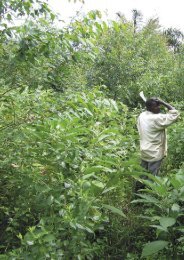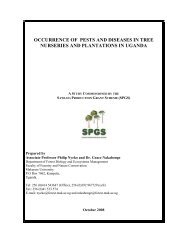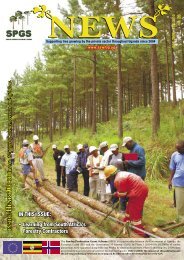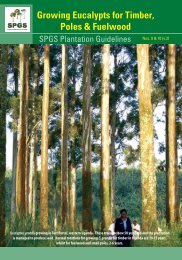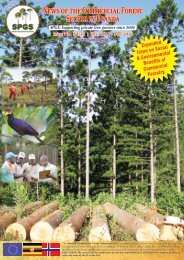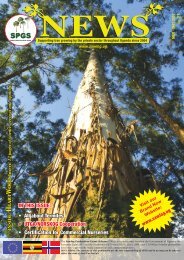You also want an ePaper? Increase the reach of your titles
YUMPU automatically turns print PDFs into web optimized ePapers that Google loves.
HeartWood No. 6 (2010)<br />
Fresh from CFA’s Edinburgh<br />
conference, we came back with<br />
suitcases full of interesting<br />
material from around the world.<br />
These have all (with other imported books)<br />
been added to <strong>SPGS</strong>’s library. Note that<br />
we have indicated where publications are<br />
available on-line too.<br />
BOOKS<br />
CONSERVATION<br />
Wrangham R and E. Ross, 2008. Science<br />
and Conservation in African Forests: the benefits<br />
of long-term research. Cambridge University<br />
Press; 254 pp. Scientific research has a<br />
long history in Uganda’s natural forests<br />
– notably, Kibale (chimps since 1970);<br />
Bwindi Impenetrable Forest (mountain<br />
gorillas since ca.1964) and Budongo<br />
Forest (chimps from 1962). The book<br />
celebrates the 20th anniversary of the<br />
Kibale Chimpanzee Project and has<br />
many lessons for us to learn with regard<br />
to long-term forestry research.<br />
CLIMATE CHANGE<br />
Read DJ et al, 2009. Combating Climate<br />
Change: A Role for UK Forests – The Synthesis<br />
Report.<br />
This report presents the key findings<br />
of the first national assessment of UK<br />
forestry and climate change. It forms part<br />
of the UK’s response to the debate on<br />
mitigating the impact of climate change.<br />
The report clearly states that that UK<br />
forests and trees have the potential to play<br />
an important role in the nations’ response<br />
to the challenges of the changing climate.<br />
The case for more woodlands is clear:<br />
“Woodland creation provides highly cost-effective<br />
and achievable abatement of Greenhouse Gas<br />
emissions when compared with potential abatement<br />
options across other sectors”. The final few<br />
sentences of this 16 page publication are<br />
telling to: “The key message of the Stern review<br />
was ‘Act now or pay later’. In view of the<br />
fact that the strength of the carbon sink provided<br />
by UK forests is weakening so rapidly, the key<br />
message from this Assessment is ‘Plant Now and<br />
Use Sustainably”. Available to <strong>download</strong><br />
from www.tsoshop.co.uk/bookstore<br />
REVIEWS<br />
PESTS<br />
Speight MR and Wylie FR, 2001. Insect<br />
Pests in Tropical Forestry. CABI Publishing;<br />
307 pp. This looks like a really useful<br />
book for us as we are starting to become<br />
more aware of the need to be proactive<br />
regarding pests (and diseases) in our<br />
plantations. The authors state early on in<br />
the book: “We must emphasize that the basis for<br />
modern pest management lies with prevention of<br />
outbreaks whenever and however possible”. The<br />
core of the book is a section on the main<br />
tropical forest pests and describes their<br />
ecology, biology and impact. Following<br />
this are four chapters on Managing Pests<br />
- starting with Planning, then the Nursery<br />
stage, the Plantation stage and then Forest<br />
Health Surveillance. Finally it has a<br />
chapter on Integrated Pest Management,<br />
which basically combines all appropriate<br />
pest management tactics into a package<br />
which reduces the economic losses caused<br />
by insects to tolerable levels. Definitely<br />
required reading for foresters in Uganda.<br />
WORK STUDY<br />
Kananwaty G (ed.), 1992. Introduction<br />
to Work Study (4th edition). International<br />
Labour Office, Geneva; 524 pp. This is<br />
the ‘bible’ for Work Study practitioners.<br />
Thanks for Rory McCaughan for recommending<br />
and sourcing this useful book for us – Ed.<br />
COMMONWEALTH<br />
FORESTS<br />
Commonwealth Forests 2010: an overview of<br />
the forests and forestry sectors of the countries<br />
of the Commonwealth - is published by the<br />
Commonwealth Forestry Association to<br />
coincide with the 18th Commonwealth<br />
Forestry Conference in Edinburgh. It<br />
quantifies and describes the present<br />
state of forestry in the countries of the<br />
Commonwealth, which account for more<br />
than one fifth of the world’s forest area<br />
and includes Uganda, Kenya, Tanzania<br />
and (much more recently) Rwanda. The<br />
report identifies common challenges and<br />
the opportunities arising from them.<br />
It is a sort of cross between a book<br />
and magazine and contains much of<br />
interest. We couldn’t help but notice an<br />
advertisement for African Development<br />
Bank’s forestry development has two<br />
photographs from <strong>SPGS</strong> (pages 94-95):<br />
though one is captioned Tanzania 2008,<br />
we can tell you with certainty that it is a<br />
2-yr old demonstration planting of Pinus<br />
caribaea var. hondurensis in western Uganda<br />
from Australian seed orchard seed!<br />
Available to freely <strong>download</strong>/read on-line<br />
at www.cfa-international.org/<br />
PERIODICALS/<br />
JOURNALS<br />
SA FORESTRY<br />
The June 2010 issue contains many very<br />
relevant features for us in Uganda. Small<br />
Growers on the Ropes tells of the problems<br />
being face by small growers in South<br />
Africa, with low yields and few replanting<br />
their crops after harvest. High transport<br />
costs (related to both distance from<br />
market and poor rural infrastructure) and<br />
fire protection were cited as the growers’<br />
biggest challenges: surely important<br />
lessons for growers here to learn.<br />
The other article that stood out in this<br />
interesting (and very practical publication)<br />
was one by Prof. Mike Wingfield, Director<br />
of Forestry & Agricultural Biotechnology<br />
11



